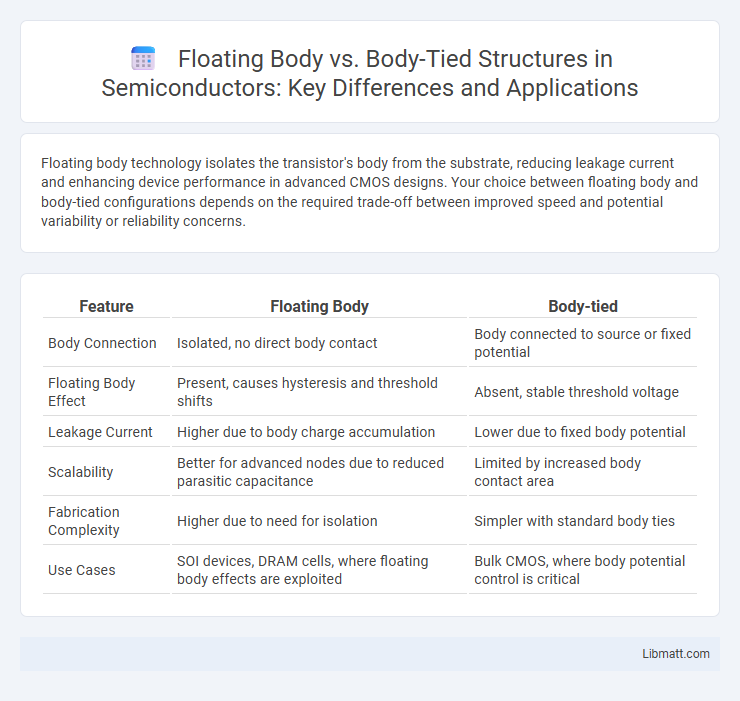Floating body technology isolates the transistor's body from the substrate, reducing leakage current and enhancing device performance in advanced CMOS designs. Your choice between floating body and body-tied configurations depends on the required trade-off between improved speed and potential variability or reliability concerns.
Table of Comparison
| Feature | Floating Body | Body-tied |
|---|---|---|
| Body Connection | Isolated, no direct body contact | Body connected to source or fixed potential |
| Floating Body Effect | Present, causes hysteresis and threshold shifts | Absent, stable threshold voltage |
| Leakage Current | Higher due to body charge accumulation | Lower due to fixed body potential |
| Scalability | Better for advanced nodes due to reduced parasitic capacitance | Limited by increased body contact area |
| Fabrication Complexity | Higher due to need for isolation | Simpler with standard body ties |
| Use Cases | SOI devices, DRAM cells, where floating body effects are exploited | Bulk CMOS, where body potential control is critical |
Understanding Floating Body and Body-tied: Key Differences
Floating body and body-tied refer to different transistor structures affecting device behavior in CMOS technology. A floating body transistor has its body terminal electrically isolated, causing charge accumulation that impacts threshold voltage and can induce parasitic effects, while a body-tied transistor connects the body to a fixed potential, stabilizing device characteristics and reducing variability. Understanding these differences helps you optimize circuit performance by selecting the appropriate transistor type for power, speed, and reliability requirements.
The Science Behind Floating Body
Floating body technology in semiconductor devices allows the transistor's body to float electrically, enabling unique charge storage effects that improve performance in applications like DRAM cells. By isolating the body from a fixed potential, floating body transistors exhibit enhanced retention times and reduced leakage currents compared to traditional body-tied devices. This electrical isolation leverages charge accumulation and threshold voltage modulation, optimizing device speed and energy efficiency.
Exploring the Body-tied Concept
The body-tied concept in semiconductor technology connects the transistor body directly to the source terminal, effectively eliminating the floating body effect seen in floating body devices. This approach reduces errors caused by charge accumulation, improving device reliability and performance in applications like DRAM cells and SOI (Silicon-On-Insulator) transistors. Body-tied transistors offer enhanced threshold voltage stability and minimize leakage currents compared to floating body counterparts.
Applications of Floating Body in Technology
Floating body technology is widely used in silicon-on-insulator (SOI) devices, enhancing performance in radio frequency (RF) applications and low-power electronics due to its reduced parasitic capacitance. Floating body transistors improve speed and efficiency in high-frequency circuits, making them ideal for wireless communication and advanced sensor systems. Your integration of floating body components can lead to more energy-efficient designs in modern semiconductor technology.
Advantages of Body-tied Devices
Body-tied devices offer enhanced stability by maintaining a fixed potential to the substrate, reducing floating body effects such as threshold voltage variability and parasitic leakage currents. This configuration improves device reliability and simplifies circuit design challenges associated with floating body-induced hysteresis and latch-up. Consequently, body-tied transistors achieve better performance consistency in analog and digital integrated circuits.
Performance Comparisons: Floating Body vs Body-tied
Floating body technology in SOI (Silicon on Insulator) devices generally offers improved performance due to reduced parasitic capacitance and enhanced short-channel effects control, leading to faster switching speeds and lower power consumption. Body-tied devices exhibit better leakage control and reduced hysteresis, making them more reliable in low-power applications but often at the cost of higher parasitic capacitance and slower overall performance. Performance comparisons reveal that floating body devices excel in high-speed and low-power logic circuits, whereas body-tied devices are preferable for stable analog and memory applications requiring minimal leakage currents.
Common Use Cases and Industry Adoption
Floating body technology is primarily utilized in SOI (Silicon-On-Insulator) devices, offering benefits for low-power applications in mobile and IoT sectors due to reduced parasitic capacitance and leakage currents. Body-tied designs dominate bulk CMOS processes, favoring high-performance computing and analog circuits where body biasing control is crucial for device stability and variability management. Industry adoption shows floating body gaining traction in energy-efficient designs, whereas body-tied remains preferred in high-reliability and RF applications.
Reliability and Stability Considerations
Floating body technology in SOI transistors often faces reliability challenges due to charge trapping and floating node effects, which can cause threshold voltage shifts and degrade device stability under prolonged operation. In contrast, body-tied configurations provide a stable reference by connecting the body terminal to a fixed potential, minimizing trapped charge accumulation and enhancing overall device reliability. Stability considerations favor body-tied designs in high-performance and radiation-sensitive applications where consistent electrical characteristics are critical.
Power Consumption and Efficiency Analysis
Floating body devices typically exhibit lower power consumption compared to body-tied counterparts due to reduced substrate leakage currents, enhancing overall efficiency in low-power applications. Body-tied transistors, while offering better control over threshold voltage and minimizing variability, often incur higher static power dissipation because of increased junction leakage. Your choice between floating body and body-tied architectures should consider the trade-off between power efficiency and device stability depending on the specific requirements of your circuit design.
Future Trends: Floating Body and Body-tied Innovations
Floating body technology is advancing with innovations in reduced power leakage and enhanced scalability for next-generation low-power devices. Body-tied designs continue to evolve through improved fabrication techniques, offering better noise immunity and higher reliability in high-performance circuits. Your choice between floating body and body-tied will significantly impact the efficiency and future-proofing of semiconductor devices as these trends develop.
Floating Body vs Body-tied Infographic

 libmatt.com
libmatt.com